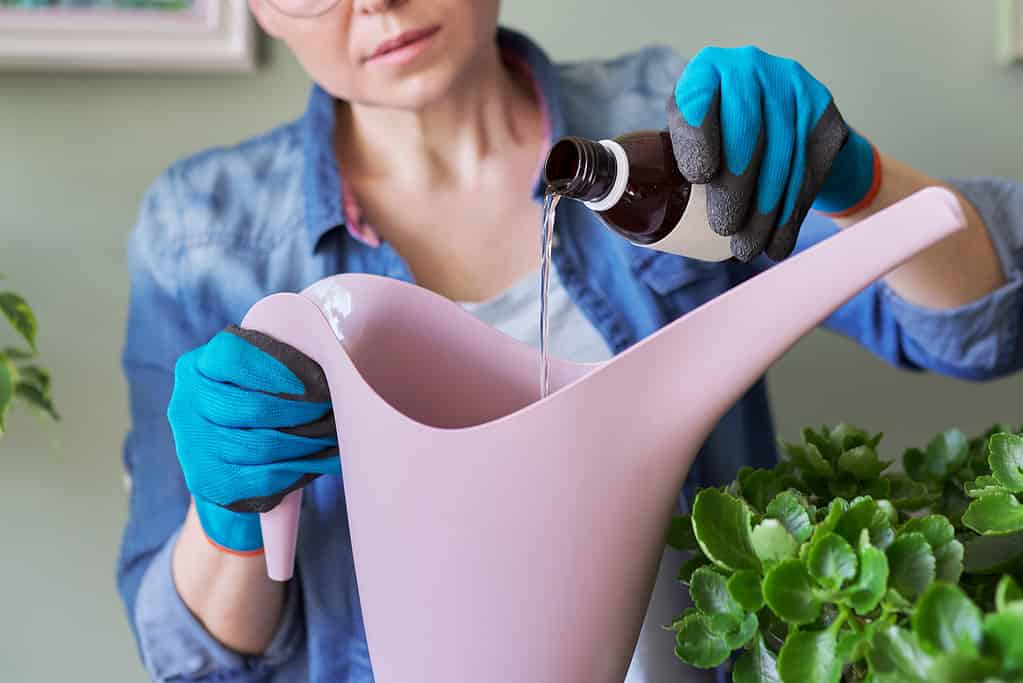Discover the Most Effective Homemade Insecticidal Soap
Homemade insecticidal soap is a perfect way to maintain both indoor and outdoor plants and protect them from insect infestations. There are so many different kinds of sprays and solutions that are chock-full of toxic and hazardous chemicals that you don’t want to carry into your house or spray into your garden. That’s why making your homemade insecticidal soap is a great alternative to these other kinds of sprays. Not only is it cheaper than buying it from the store, but making your own insecticidal soap is incredibly easy, efficient, and hassle-free. Read on to discover more benefits of homemade insecticidal soap and how to make your own!

©Valeriy_G/iStock via Getty Images
What is Insecticidal Soap?
Insecticidal soap is a great alternative to pesticides and other toxic sprays that keep insects and bugs off your plants. It defers soft-bodied pests like aphids, spider mites, and whiteflies away from your indoor and outdoor plants. In addition to just insects, it can also rid your plant of leaf fungi like sooty mold. While these other pesticides and sprays can do the job as well, it can harm your plant. If you have an indoor plant, these sprays can harm the air that you’re breathing as well. Making your own insecticidal soap is an easy, cheaper, and healthier solution that your plant will thank you for.
A warning though: there are sources that say using liquid dish detergent and dish soap is another way to take care of your plant. While it is possible to buy safe soaps and other organic options, these kinds of products are still deep cleaning products. They are designed to strip grease and oil off of surfaces. This can dry out your plant to an unhealthy level and cause irreversible damage.
How to Make Homemade Insecticidal Soap
So, how do you make your own homemade insecticidal soap? There are many different recipes found on the internet, and some will work better for your plant than others. It’s recommended that once you’ve made your solution, you test it out on a small leaf on your plant to see how it reacts. If the leaf doesn’t dry out completely and shows no adverse reactions, you should be good!
Additionally, your soap choice is important. Use pure liquid castile soap and avoid all products that have fragrance, moisturizer, and any other kind of additives that could harm your plant. Do not use dish detergent!
One more thing: the use of oil in your soap is up to you. While oil isn’t necessary for the soap to work, it will prolong its shelf life and it will enhance the overall effectiveness of your spray.
Alright, now for the recipe!
Recipe for Homemade Insecticidal Soap with Oil
Ingredients You’ll Need
- 1 tablespoon pure liquid castile soap
- 1 cup cooking oil
- Water
- Clean jar with airtight lid
- Clean spray bottle
Directions
If you want to make your soap with oil, you’ll first want to use a clean jar that has an airtight lid. Then, mix 1 tablespoon of pure liquid castile soap with 1 cup of cooking oil. Blend by shaking the jar with a lot of force. After you’ve got your solution, you’re only going to mix the solution with water as needed. So when it’s time to spray, get a clean spray bottle and fill it with one cup of water, and mix 1 to 2.5 teaspoons of the base you just made and spray immediately onto your plant. Wash out the spray bottle once you’re done and refill as you need.
Recipe for Homemade Insecticidal Soap Without Oil
Ingredients You’ll Need
- Pure liquid castile soap
- Water
- Clean spray bottle
Directions
You’ll want to start this process by trying to make the weakest solution possible. Use between 1 teaspoon and 3 or 4 tablespoons of soap per gallon of water until your solution is working effectively on your plant. Once your solution is made, use it immediately.
Other Important Things to Know
For your homemade insecticidal soap to work effectively, the insect will need to have direct contact with the solution. You can do this by completely soaking the leaves from top to bottom and by spraying any insect you see. This is the only way that your spray will be effective.
Additionally, you’ll want to wear gloves when applying your spray to the plant. Some people can get rashes, so it’s always better to play it safe rather than sorry.
Finally, avoid spraying your solution onto plants when it’s 90º or hotter outside. Spraying it onto your plant when it’s hotter than 90º can cause phytotoxicity, or the inhibition of plant growth.
Conclusion
Making homemade insecticidal spray is a fantastic alternative to buying plant sprays that have toxins and other harmful chemicals in them. It’s easy, cheap, and effective, and your plant will be grateful to not be covered in pesticides. Make sure you pay attention to your plant, and if it isn’t taking to the solution you’ve crafted, look into other recipes and solutions that might be more viable for your plant. Happy gardening!









